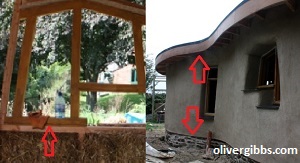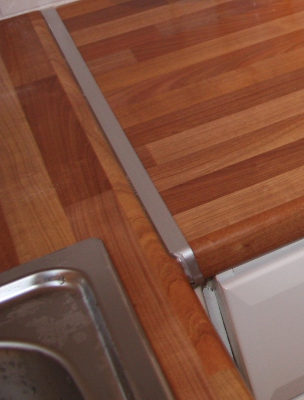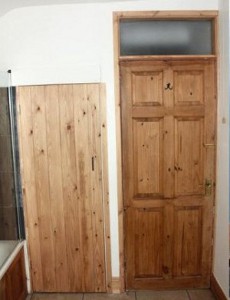Pest proofing straw bale homes

A glance at websites on straw bale homes might give you the impression that pests and straw do not mix. Wrong! It maybe uncommon, but pests can inhabit straw bale walls, as a client recently discovered.
A problem with moths
Two years ago we did carpentry and joinery work for a neighbour who was building an ecological office using lime rendered straw bales. When we returned to do further carpentry work recently, we found that he was having problems with moths in his building. Being involved in ecological construction, we were interested to find out more about pest proofing straw bale houses. Here’s a summary of our findings:
Types of pests in straw houses
Various websites describe home builders’ experiences of pests in their straw bale buildings. In the UK, the types of pests included:
-
- Moths – a small silvery type like those found on clothes. One couple described an infestation leaving deposits of hundreds of moths in their home every day.
- Mice . Despite what some construction firms’ claim, people have found that mice can nibble through thin render and burrow through tightly packed straw walls.
- Saw Tooth Grain Beetle – a beetle and larva commonly found in dry food and grain products. One person found that their presence in straw walls set off their smoke alarms!
- Psocid. Never heard of them? They are tiny insects that normally live in tree bark but can also dwell in thatch. One website reported a couple of infestations in straw bale homes.
Causes of pests in straw walls
Pests and vermin are either in the straw when the bales are laid or they enter the walls at a later point. Two factors seem to provide an open invitation to creatures: exposed or inadequately rendered straw – that gives pests access – and moisture – that aids insects’ breeding.
Preventing pests in straw construction
As with many problems, prevention is the best cure. A well-constructed straw building will prevent pests from thriving. An experienced architect and builder should ensure that a building is designed and made in a way that reduces the risk of moisture and straw exposure. Here are a few tips from those in the straw bale building industry:
– Reducing straw exposure
- Fit the bales quickly to reduce the time that pests have to move in. Magwood et al also suggest selecting bales of straw that do not have much seed to ensure that mice do not have a ready food supply.
- Render the straw walls with at least three coats of render, as a mouse can chomp through a thin coat.
- Two vulnerable points in the building are where the wall meets the floor joists and where walls meet the ceiling posts. Ensure that the straw in these areas is well sealed and not left exposed.

Points of vulnerability on straw bale homes
- Seal small cracks and crevices in the render around pipes, wiring and frames. Maintain the render and fill holes that appear in the walls with age.
– Restricting moisture in straw walls
Damp straw can be caused by liquid or water vapour, leaks or condensation. In his comprehensive guide to building straw bale homes, Brian Hodge suggests various steps to prevent water damage in straw bale construction. This includes the following.
- Ensure that the bales are kept perfectly dry and tightly compressed when making the walls of the building. If you suspect that the straw has got wet, do not use the bales.
- Prevent condensation by filling gaps between wall linings and pipes and windows and the window frames; fit insulated water proof sleeves around pipes; and a vapour barrier behind the plaster, particularly in damp rooms like bathrooms (proper ventilation would also be needed).
- Reduce the amount of horizontal render, which is vulnerable to water collection. For example, Hodge suggests fitting windows flush to the external face of the wall.
- Construct a roof with a good overhang to shield the walls from rain. Hodge suggests at least a 1.8 meter overhang.
- Fit sills under windows with an overhang, capillary groove and flashing underneath.
– Boron treatment of straw
Borates like Borax are used in the UK for killing a variety of insects, including Wood Worm, Death Watch Beetles and Fleas. While we had not heard of it being used as an insect repellant in straw homes, Boron is used on straw walls in South Africa to prevent termites. We could not find technical details, but one paper recommended a 1.5% dilution of Boron for treating MDF against termites (approximately 0.15kg of powdered Boron diluted in 12.5 litres of water). The Boron solution is sprayed on the external surfaces of the straw after pinning the bales in the wall structure. If tried, proper safety precautions should be taken in applying the solution to avoid health problems and environmental leeching. The straw would also need time to fully dry before rendering.
Treating pests in straw walls
But what if you already have a swarm of unwanted critters in your straw walls? The two ways of terminating pests in bale walls appear to be plugging openings and applying pesticides.
– Plugging holes
Dr Owen Geirer advocates using painters’ caulk to fill cracks and crevices in render and then spraying the surface with drywall texture. Hodge suggests expandable foam or wadding like sheep’s wool for filling areas around pipes. If thoroughly sealed, the pests should die and further infestations should be prevented.
– Pesticides
People applied liquid pesticides to the cracks in the render to kill the insects in the straw walls – you can find out about relevant insecticides online but it probably wise to get advice from a pest control firm. Mice were dealt with using conventional poison – although one said that the rodents only took liquid not solid bait because of other available food. Cracks were later filled to prevent repeat infestations.
– Organic solutions
For the more environmentally minded, we found some references to natural pest control. One used a sonic repellent to get rid of the mice in their walls. Our client is trying parasitic wasps to kill their moths. These microscopic ninja wasps are placed on the exposed straw and supposedly attack the moth eggs and disrupt their breeding cycle. We will let you know how they get on!
That’s a summary of our trawl of relevant websites. However, although we are carpenters & joiners with experience of building eco-homes, we are not experts in straw building or pest control. Straw bale construction is relative new field in this country and we would like to know more.
Let us know if you have experienced any problems with pests in straw bale homes and what was done about them by posting below.



0 Comments